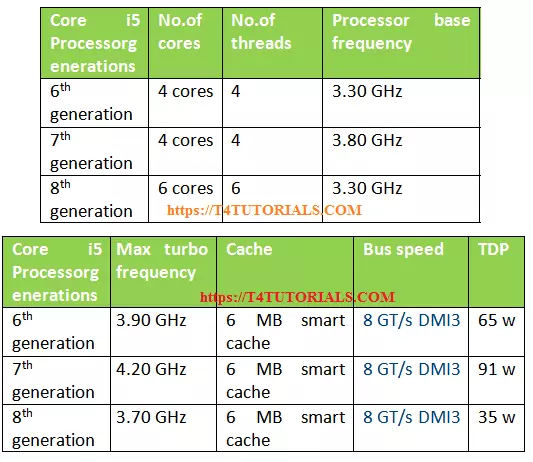Explain Difference Between 6th & 7th Generation Processors
6th Generation Intel Core Desktop Processors. It was unique among Intel desktop CPUs.
What Is The Difference Between 6th Generation And 7th Generation Intel Processors Quora
Explains the differences between Intel Core i9 i7 i5 and i3 in different generations of the Intel Desktop Processors.

. Generations of the computer processors4 1st Generation. 7th Generation Intel Core Desktop Processors. Could address 1MB of memory.
Differences in Paper Formatting. The 7th gen processor which Intel codenamed Kaby Lake was introduced in 2016. Processor numbers for 6th through 9th Generation Intel Core processors start with a single digit indicating the generation number followed by a three-digit SKU number.
Skylake 6th Generation Intel Processors. Concise technical data is. Turbo Boost refers to Intels overclocking feature built into its processor which allows the processor to run faster than its base clock speed when only one or two processor cores are needed.
4th gen is 22nm Haswell. G4560 7th gen pentium and i3 6100 6th gen i3 for example are both 2 core 4 thread both 14nm dies both 3mb cache both similiar clock speedsIPC. 8086 One of the first processors of 16bits and 16bit data bus.
It has the same 14nm process technology. I3 6300 and 6320 are both a little faster 4mb cache and slightly higher clock speeds but more expensive and harder to find. In general Core i5 processor uses the Turbo Boost.
Do not let the same LGA1151 socket trick you 7th8th gen are not cross compatible. Introduced in the middle of 1978. It used the same 14nm process technology as the previous one.
Tick tock was a strategy where Intel used to alternate between manufacturing processors on a smaller die tick and updating the architecture of the processors tock. The 7th-gen Kaby Lakes video processing engine for example was greatly improved and it generally ran at higher clock speeds than 6th-gen Skylake could. Meanwhile modern Core i7 processors range from quad-core all the way up to octa-core.
This can seem confusing but the general rule is that the first number relates to the generation processor it is. 4th gen and 5th gen would be interesting. The title pages Figure 21 and Figure 22 and the running head are the changes of interest.
And i7-6700 is an i7 6th generation 700 CPU. 11th Generation Intel Core Desktop. Ad A Free Clear Hypoallergenic Detergent Tested For Your Comfort.
While 5th gen is 14nm like the rest it was a different architecture and had that 128MB L4 cache and beefed up graphics. Our Biodegradable Formula Contains No Dyes Synthetic Fragrances Or Optical Brighteners. Sample papers for both are located at 228 or on the APA site.
There are now two formats for an APA paper the student paper 22 and the professional paper 21. Was a little too modern for the actual market. 6th gen would look identical to 7th gen.
Moreover it features higher turbo frequencies faster CPU clock speeds and clock speed changes. What are the differences between Intel Core i9 i7 i5 and i3 in 10th 9th 8th 7th and 6th Generation Intel Core Desktop Processors. So as for Core i3 vs i5 Intel Core i5 would provide better clock speed.
It is difficult for many of the customers to choose the processors from the distinct families of core i5 and core i7. Within each family there are enormous processors inbuilt with variable CPU clock rates at varied costs. 6th to 9th Generation Intel Core Processor Families.
This is often where bargain-hunting PC gamers look for solid deals on processors. Their Core i5 CPUs for desktop PCs boast 6-cores while mobile Core i5 processors are again mostly quad-core. The 7 th Generation Y-series and U-series we mentioned before.
The i5 parts also generally have higher clock speeds a larger cache and can handle more memory. H110 B150 B250 Z170 Z270 for 7th gen Z370 H370 H310 and B360 for 8th generation. 7th generation Kaby Lake.
The professional paper targets items to be published. A step up from Core i3 is the Core i5. Introduction to Difference Between Core i5 vs Core i7.
Intel did not do much in the coming generation. When applicable an alpha suffix appears at the end of the processor name representing the processor line. It only redesigned its 5th gen processor and remarketed it as 6th Gen.
They feature dual-core processors designed for maximum battery life and fanless designs. This generational list of Intel processors attempts to present all of Intels processors from the pioneering 4-bit 4004 1971 to the present high-end offerings. 6th and 7th gen are though.
They also use different chipsets and motherboards. To put that in perspective Intels 5th generation Broadwell processors were the tick and the 6th generation Skylake processors were the tock. Kaby Lake was a refreshed version of Sky Lake architecture.
So an i7-7600 is an i7 7th generation 600 CPU. Refer to page 8 in 7th Generation Intel Core Desktop processors product brief to view the differences between i7 i5 and i3. 6th Generation Skylake.
An i5 typically lacks Hyper-Threading but it has more cores currently six rather than four than Core i3. This generation includes an improved GPU and CPU performance and low power consumption. Refer to page 6 in 6th Generation Intel Core Desktop processors product brief to view the differences.
Kaby Lake 7th Generation Intel Processors. The 6700K and 7700K were nearly identical CPUs.
What Is The Difference Between 6th Generation And 7th Generation Intel Processors Quora

What Is The Difference Between Core I5 6th 7th And 8th Generations T4tutorials Com

Intel Outs Complete Range Of 7th Gen Core Kaby Lake Processors For Desktop And Mobile Hardwarezone Com Sg
No comments for "Explain Difference Between 6th & 7th Generation Processors"
Post a Comment